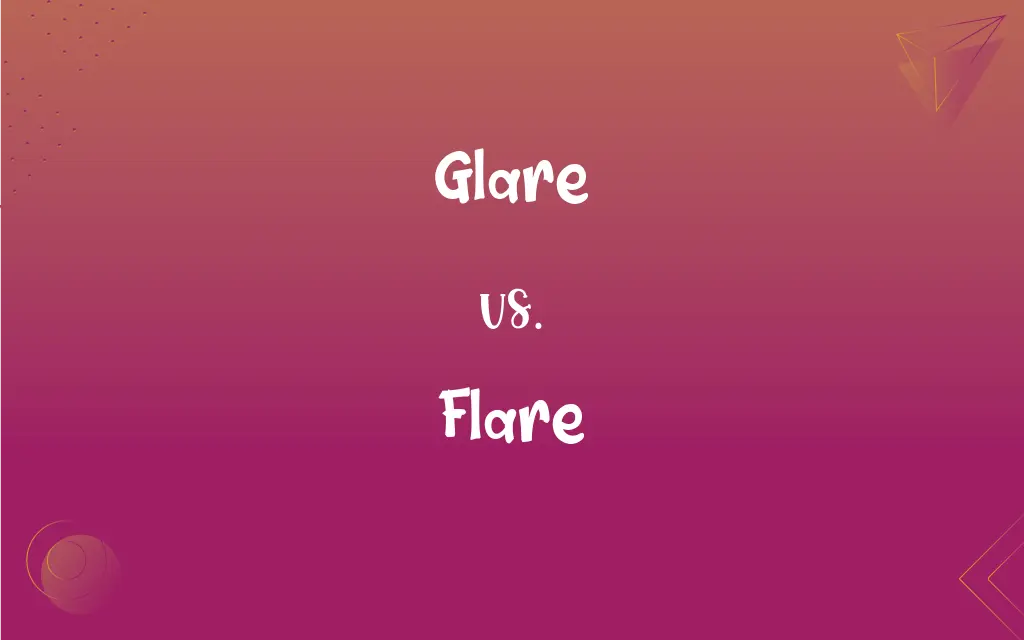Glare vs. Flare: What's the Difference?
Edited by Aimie Carlson || By Janet White || Updated on February 5, 2024
"Glare" is intense, uncomfortable light or a hostile stare; "flare" is a sudden burst of light or flame or to widen out.

Key Differences
"Glare" refers to a strong, dazzling light that makes vision difficult, or it can describe an intense, angry stare from a person. "Flare," on the other hand, signifies a sudden burst of light or fire, often used for signaling or illumination, indicating both a physical phenomenon and a functional tool. While glare often conveys discomfort or aggression, flare implies emergence and visibility.
In the context of light, glare is usually unwelcome, emanating from reflective surfaces or direct, bright sources, causing squinting or discomfort. Flare, conversely, can be both an unplanned manifestation, like the flare-up of flames, or a deliberate signal, such as a distress flare. The nature of glare is persistent, whereas flare is transient, symbolizing fleeting intensity.
When considering human interactions, a glare is a powerful form of non-verbal communication, expressing displeasure or hostility without words. Flare does not have a direct human emotional expression but can metaphorically describe emotions or situations escalating quickly, highlighting the difference in application between the two words.
Photographically, glare is often an issue to be mitigated, as it can obscure details and overwhelm the scene with brightness. In photography and observation, flare can add dramatic effect or be an obstacle to clear vision, requiring specific techniques to manage or utilize its effect aesthetically. Thus, in both photography and everyday perception, glare and flare present challenges and artistic opportunities.
Technically, glare results from excessive brightness contrast, leading to visual discomfort or impairment. Flare, especially in optics, refers to a scattering of light that produces a particular visual effect, often seen around light sources in photographs. This distinction highlights the nuanced ways both phenomena interact with light and vision.
ADVERTISEMENT
Comparison Chart
Definition
Intense, uncomfortable light or a hostile stare
Sudden burst of light or flame, or to widen
Context
Often negative, causing discomfort or expressing anger
Used for signaling, illumination, or showing a widening effect
Nature
Persistent and steady
Transient and ephemeral
Emotional Connotation
Hostility, anger
Emergence, distress signaling
Photographic Relevance
Problematic, needing mitigation
Can add drama or requires management
ADVERTISEMENT
Glare and Flare Definitions
Glare
Reflective brightness causing discomfort.
The glare from the snow was nearly blinding.
Flare
A sudden burst of light or flame.
The flare illuminated the night sky.
Glare
A fierce or angry stare.
She silenced the room with a cold glare.
Flare
To burn with a sudden and unsteady light.
The campfire flared up suddenly.
Glare
Intense and blinding light.
The glare of the noon sun made it hard to see.
Flare
A device used to produce a bright light for signals.
They used a flare to signal for help.
Glare
To shine with a strong and harsh light.
The headlights glare through the fog.
Flare
To expand or open outward in shape.
The skirt flares at the hem.
Glare
Unpleasantly bright or strong light.
The computer screen's glare strained his eyes.
Flare
A sudden outbreak of emotion or conflict.
Tempers flare during the heated debate.
Glare
To stare fixedly and angrily.
Flare
To flame up with a bright, wavering light.
Glare
To shine intensely and blindingly
A hot sun glared down on the desert.
Flare
To burst into intense, sudden flame.
Flare
To erupt or intensify suddenly
Tempers flared at the meeting. His allergies flared up.
FAQs
Is glare always associated with light?
Primarily, but it can also refer to a type of hostile stare.
Can glare be harmful to eyes?
Yes, prolonged exposure to glare can cause eye strain and visual discomfort.
Can glare be used positively in art or design?
While often seen as a nuisance, glare can be used creatively to convey intensity or emotion.
How does glare affect driving?
Glare from the sun or headlights can significantly impair visibility and reaction times.
Are flares always used for emergencies?
Primarily, but they can also be used for signaling or lighting in non-emergency contexts.
How can one reduce glare on a computer screen?
Adjusting screen brightness, using anti-glare screens, or changing viewing angles can help.
Can flare be prevented in photography?
Using lens hoods or adjusting angles can minimize flare.
Are there different types of flares?
Yes, including emergency, illumination, and signal flares, each with specific uses.
What causes flare in eyesight?
Flare in vision can be caused by bright lights, especially at night, indicating light scattering in the eye.
What are some common solutions to reduce flare in lighting design?
Strategic placement of lights, use of diffusers, and controlling the light direction can help minimize flare.
Do all cameras produce lens flare?
Most lenses can produce flare under certain lighting conditions, but it varies by lens design.
How long do emergency flares last?
The duration varies, but typical road flares burn for about 15 to 60 minutes.
What's the significance of flare in movies?
Lens flare can add realism or a stylistic element to scenes, often used creatively by filmmakers.
Can glare come from artificial lights?
Yes, artificial sources like headlights or screens can produce glare.
Can glare affect animals?
Animals can be affected by glare, particularly those with sensitive eyesight, though their reactions may vary.
Is it possible to measure glare?
Yes, there are several metrics and tools to quantify glare in terms of its intensity and impact on vision.
Can sunglasses protect against glare?
Yes, sunglasses, especially those with polarized lenses, can reduce glare.
What materials are most likely to cause glare?
Highly reflective surfaces, such as water, snow, or glass, can cause significant glare.
Is flare a problem in optical devices?
Yes, flare can affect the performance of optical devices, reducing contrast and clarity.
How do emergency services use flares?
Flares are used for marking locations, signaling distress, or providing light.
About Author
Written by
Janet WhiteJanet White has been an esteemed writer and blogger for Difference Wiki. Holding a Master's degree in Science and Medical Journalism from the prestigious Boston University, she has consistently demonstrated her expertise and passion for her field. When she's not immersed in her work, Janet relishes her time exercising, delving into a good book, and cherishing moments with friends and family.
Edited by
Aimie CarlsonAimie Carlson, holding a master's degree in English literature, is a fervent English language enthusiast. She lends her writing talents to Difference Wiki, a prominent website that specializes in comparisons, offering readers insightful analyses that both captivate and inform.































































